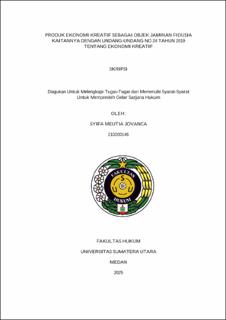| dc.description.abstract | The creative economy has become a growing trend in society due to its
nature as an intangible asset with significant economic and investment potential. It
is considered a renewable and unlimited resource. This sector includes ideas,
concepts, and human creativity, all of which are highly dependent on the protection
and enforcement of Intellectual Property Rights (IPR). In the development process,
IPR arising from the creative economy can be used as fiduciary collateral with
government facilitation. This is stipulated in Article 16 paragraph (1) of Law No.
24/2019, which mandates the government to support creative economy actors
through intellectual property-based financing schemes, enabling them to obtain
funding or credit from banking and non-banking financial institutions. This
research aims to examine the regulation of creative economy products as objects
of fiduciary collateral and the challenges involved in utilizing such products for
that purpose.
This study uses normative legal research methods, relying on secondary
data sources, including primary, secondary, and tertiary legal materials. Data were
collected using literature review techniques and analyzed using qualitative data
analysis methods.
The results of this study conclude that although there are 17 sub-sectors
within the creative economy, not all products can automatically be used as fiduciary
collateral. There are four key requirements that must be fulfilled: a creative
economy business financing proposal, proof of ownership of the intellectual
property of the product, proof of ownership of the creative economy business, and
an intellectual property certificate. In practice, implementation is still hindered by
the absence of technical guidelines for the intellectual property-based financing
scheme, unclear valuation systems for intellectual property assets, and a lack of
certified intellectual property appraisal institutions authorized by the government. | en_US |


